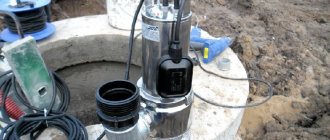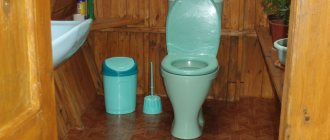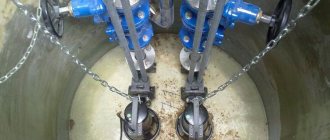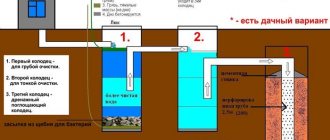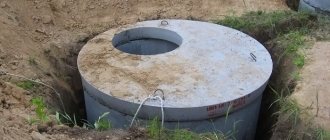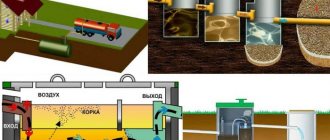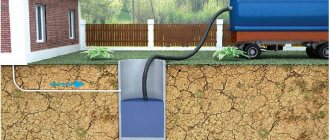If you are the owner of a private house or cottage, then you have probably appreciated the usefulness of pumping equipment, which allows you to solve many problems related to providing your home with water, installing a sewer system, and watering your garden. Even in a situation where wastewater cannot be removed by gravity, fecal pumps come to the rescue. However, high-tech, high-quality and durable models are not cheap. But don’t despair, because you can make a sewer pump with your own hands. Without a doubt, in terms of functionality it cannot be compared with factory models, but it can be used as an inexpensive alternative.
Features of drains
To collect wastewater from a country house or dacha, a cesspool is built on the site or a septic tank is installed.
In any case, it is necessary to periodically pump out silt deposits and solid impurities from this structure. Even when using a modern multi-chamber septic tank, in which bacteria are responsible for processing waste, periodic cleaning of sewage waste will be required. The best mobile application for experienced players has appeared and you can have a phone with all the latest updates and discover sports betting in a new way.
It’s good if there is free access for a sewage disposal truck to the treatment plant. Otherwise, you will have to use a factory-made or homemade fecal pump. In any case, the installation of such equipment must be carried out according to all the rules, so when doing the work yourself, it is worth familiarizing yourself with the nuances and sequence of installation.
If the septic tank or cesspool is not cleaned in a timely manner, this can lead to serious problems. As a result, the carrying capacity of the soil may deteriorate, which will lead to the accumulation of a large amount of wastewater in the container. The accumulated wastewater will spill onto the site and cause deterioration in the sanitary condition of your site.
Purpose of the fecal pump
As we have already said, silt deposits and solid impurities accumulate on the walls of cesspools, which cannot be absorbed into the soil like water. As for septic tanks, bacteria cannot cope with all the waste and some of it settles on the bottom and walls of the container. To maintain the operation of the sewer system, as well as maintain a favorable sanitary situation, these structures need to be cleaned periodically.
A fecal pump is best suited for this task. This is a special pumping unit that grinds and pumps sewage from a sewage facility.
How to make a water pump with your own hands?
Attention: a conventional water pump is not suitable for such purposes, since its impeller will quickly become clogged with large waste particles, which will lead to overload of the electric motor and its failure. Only a special fecal pump or its homemade equivalent can process solid sewage waste.
Details
Causes of clogging
Before moving directly to the topic of the article, I would like to understand the reasons for the appearance of blockages. The fact is that each of them requires a certain approach to itself, and if you incorrectly determine the reasons, then you will need to tinker with the blockage for a very long time.
With a kitchen sink, everything is simple and clear, and the causes of blockages can be small blockages that gradually begin to layer in a certain place in the pipe. But the debris itself cannot do this, and in order for it to begin to accumulate, a sticky material is required. Oils and fats act as it inside the sewer system.
This is the reason why all the experts say that only installing a grease trap can prevent the formation of blockages in the sewer system. Oil plugs can be dealt with using all sorts of methods, and everything will depend on the thickness of the accumulated layer in which debris has already begun to accumulate. We'll talk about this further.
As for the bathtub and sink, as well as the shower box, the causes of blockages inside them are hair and soap. This is the most unpleasant type of blockage, because it can only be removed mechanically, i.e. remove those same hairs from the pipe. In addition, we note that soap, in combination with other types of debris, creates a strong plug that is not easy to get rid of. And the last plumbing fixture where a clog can appear is the toilet. True, problems here are rare, but it can happen. The reason could even be a piece of low-quality toilet paper, but due to the fact that the toilet flush design has a diameter of at least 10 cm, the problem can be quickly and easily solved.
Methods for clearing blockages in a sewer pipe
There are 4 main technologies that can be used today to clean sewer pipes:
- Hydrodynamic.
- Thermal.
- Chemical.
- Mechanical.
We propose to look at each of them separately and choose which one is better and more effective in all individual situations.
Mechanical
Already from the name it is clear that the implementation process requires special plumbing tools, and there are two of them - a plumber's cable and a plunger. Everything is clear with the latter, it has been used at home for a long time, but not all modern people use such a device, but in vain. Sometimes just such a tool helps to quickly solve the identified problem. How to do it?
- Fill your kitchen sink with water, ideally warm or even hot.
- Insert the rubber cap inside the plunger exactly in the middle of the drain hole.
- Make several pumping motions by pressing on the plastic or wooden handle.
- You need to press lightly, but sharply, and the handle should be vertical.
- If the blockage is small, this is usually enough.
- If it doesn't work the first time, repeat the procedure.
Now let's talk about cleaning the sewer with a cable yourself. Previously, every good apartment owner always had a 3-meter long plumbing cable in his arsenal of tools. At the moment, most people don't know what it is. Cleaning sewer pipes using a cable is far from the easiest process. Firstly, this requires two people if the rope is the simplest. Secondly, it must be selected according to the length of the sewer pipe. And if there are no inspection holes along the sewer circuit, then sometimes you need a device with a length of up to 22 meters, but it is quite difficult to use it manually. How to clean pipes correctly:
- At the end of the cable there is a handle in the form of a brace, because one holds on to it, and if necessary, begins to turn the handle.
- The second person will push the opposite end into the sewer pipe.
- It turns out that inside the pipe the cable performs two movements at once - rotational and linear. Only this method can break through a complex mud plug.
It is extremely important to perform the operation correctly. There should be no sudden movements - neither pushing nor rotating. As soon as the cable starts to push against the traffic jam, both people will feel it. It is important not to overdo it, and you should not push further, making an effort. In addition, the rotation speed cannot be increased. The main task is to destroy the blockage, and therefore it is required to continue at the same pace. If you feel that the cable is not moving further, then you need to pull it out of the sewer pipe. Most likely, its end is covered with dirt. It needs to be cleaned, and again into battle. As a rule, a second time is enough to break through the cork.
The video shows how DIYers clean a drain with a plumber's cable. Keep in mind that the cable does not pass through a 90 degree elbow, so it is important to use the revisions as places to push the device through. And now a few words about the types of plumber's cable. They are presented on the market in two varieties - a simple cable woven from a large amount of steel wire, and in the form of a spring, namely the twisted version. The assortment is rich even in terms of sizes.
This applies to both diameter and length, and even today plumbing cables are equipped with attachments for cleaning sewers with your own hands:
- Spiral - it is screwed into the cork and you can pull everything out.
- Ball - they usually use it to push the blockage further down the pipe towards the riser, where the plug ends up in a pipe with a huge diameter.
- Crown – Helps cut the cork.
There is another point. Today, craftsmen use special cables that can be used alone. The cable is wound on a drum, to which an electrical device, for example, a drill, is attached. It turns out that with one hand you can push it into the pipe, with the other you can press the button on the handle, which will cause the cable to rotate.
Chemical
Let's move on to the traditional method for sewer cleaning in a private house or apartment, which is used by housewives. For this, various gels, powders and liquids are used, which are simply poured into the drain hole of the plumbing fixture along with tap water. The wide variety of chemicals has made the problem of selection difficult. But this is not so important, the main thing here is different:
Strictly follow the instructions that the manufacturers wrote on the label. For example, if you need to pour one cap into the drain, then you do not need to fill 2-3 caps. If it is written that you need to pour the drug, and after ½ hour pour in warm, hot or cold water, then do not confuse anything, because the result may disappoint you.- There are a couple of types of drain cleaning chemicals in stores - alkaline and acidic. Firstly, they cannot be mixed with each other when added to the sink. A chemical reaction inside a pipe or siphon will cause an explosion and release of reaction products. The consequences can be the most unpredictable, and you also need to carefully select the dosage of acid drugs. A large number of acids corrode plastic pipes, and this is a more serious problem than a plug of dirt.
- Precautionary measures must be observed - manufacturers indicate them on the packaging.
- Cleaning operations using chemicals must be carried out with open windows or doors; efficient ventilation can be used.
Please note that advertised cleansing formulations are not always the most effective.
There is another point - you cannot use the chemical method of cleaning drains in your house with your own hands as the main option. Chemicals are more suitable as preventative measures or in cases where the mud plug is soft and small. The video shows an experiment to determine which chemical is better - cheap or expensive.
Thermal
This method for cleaning the sewer system was used at a time when no one knew about chemicals, or when there was no cable and plunger at hand. To do this, they used a large amount of hot water, which was poured into the drain holes of plumbing fixtures. This can be done using the following methods:
- Pour in hot water in buckets.
- Insert the hose into the pipe, and it should be connected to hot water, and the other end of the hose is pushed inward as needed.
Today, the thermal purification option is no longer used, and it is easier to pour liquid or gel into the sewer.
Hydrodynamic
Flushing the sewer using this method involves using water under enormous pressure. A high-pressure jet can break up any blockages, even the most complex ones, which indicates the high degree of effectiveness of the method. Most people have encountered cars that break through mud plugs in the city sewer network. Now there are small-sized devices that perform a similar function.
They are used to clean the system in a private house or multi-story city building. The device must be connected with a hose to the water supply, and the second one, from which water will be supplied under pressure, is pushed into the sewer pipe. In this case, the main thing is to choose the right nozzle, which is selected taking into account the type of blockage. The working principle of the nozzle in the pipe is interesting - holes are made on its back wall through which water is partially thrown out with great force. This reactive force will push the nozzle, and therefore the hose itself, forward. Advantages of this method:
- High efficiency.
- Safety of pipe routing.
- The service life of the pipes will not be shortened due to gentle pressure.
- The method can be used in any, even the most difficult sewerage system (in terms of contour configuration).
- The method is environmentally friendly.
- Even ice blockages in pipes can be broken with water pressure.
The video shows how a hydrodynamic type cleaning installation for pipes works.
What do you need to assemble a pump yourself?
It is not difficult to make a fecal pump with your own hands, because its design is relatively simple. First you need to understand the main components and their purpose, as well as understand the principle of operation. The most important advantage of a homemade pump is its low price compared to similar factory-made products.
To assemble homemade pumping equipment for pumping out sewage, you will need the following parts:
- pumping unit of the “Baby” modification;
- fine mesh;
- metal slats;
- strong rope;
- welder.
Attention: to assemble a sewerage pump with your own hands, you do not need to disassemble the basic pumping device and change its technical characteristics. It is enough to install a filtration mesh at the inlet pipe, which will allow only wastewater with a particle size of solid impurities acceptable for this equipment to enter the unit.
Fecal scraper with cutting mechanism
To pump out viscous masses with solid inclusions, the installation must have a grinder. There are several variations of them that are found in different installations.
- Impeller with knives. The cutting element is fixed to the screw itself. Some may have a cast iron chopper.
- Cylindrical scissors-knives.
- Cross cleaver.
- Cutter. The operating principle is reminiscent of a household kitchen meat grinder.
- Lamellar cutters.
Each of these shredders has its own operating principle. But efficiency largely depends on the grade of steel used.
Therefore, when choosing a unit, pay attention to the cutting mechanism.
Assembly, installation and maintenance
It is immediately worth noting that a homemade fecal unit is not suitable for multi-storey country houses and cottages. It is suitable for pumping out sewage from a small one-story house or cottage.
Work on assembling the unit is carried out in the following order:
- First you need to make a cage for the future fecal pumping device. To do this, a steel frame is made from metal slats, onto which a mesh with small cells is stretched. There is no need to take a very fine mesh; it is enough that the cell sizes are no more than 1x1 cm. Such a mesh will prevent large particles from clogging the pumping equipment, and the unit can easily handle impurities less than 10 mm on its own.
- A strong rope or cable is tied to the top of the cage. The pump itself is installed inside this cage.
- The unit is installed exactly in the central part of the septic tank (at the bottom). In this place, pumping equipment will not be able to pump silty layers, but will simply destroy them. Also, this arrangement will protect the unit from clogging with fatty substances floating on the surface.
- To prevent breakdowns of a homemade unit, you need to clean it and change the filter once a month.
Tip: you can use hot water to clean the fecal pump from grease. To do this, the pumping device is removed from the pit and placed in a container with boiling water for 5-10 minutes. During this time, the fatty deposit dissolves.
Installing the device at home for a cesspool
Installation of semi-submersible
A special platform is made on the wall of the tank. The electric pump will be securely fixed on it.
Considering that its body is not airtight, a float mechanism and a water level sensor are installed. A pipe for pumping wastewater is immersed into the source. At the same time, the electric pump itself is protected from possible moisture from entering from above.
Installation of submersible
There are several ways to install a self-priming unit for a private home.
- A platform is made at the bottom of the septic tank.
- A sewage pump is attached to the site using anchors.
- A pipe for pumping out liquid is brought to the surface.
- A chain or steel cable is attached to the device.
- At the same time, the electrical cable and pumping pipe are connected.
- To pump liquid, the pump is carefully lowered along a cable and immersed in the source.
- After pumping the sewer, the pump rises.
Surface mounting
The principle of operation of a surface fecal pump requires installation of the motor on the surface. At the same time, it is mounted on a flat and durable surface. The unit has two pipes: through one the liquid is sucked in, and through the other it is pumped out.
The secured hose or pipe is immersed into the source. If it is impossible to install the unit permanently, after completion of the work everything is disassembled and removed. If it is possible to protect the motor from rain and other atmospheric phenomena, then the system operates in stationary mode.
Installation errors
When installing a sewage pump, you should avoid the following mistakes:
- Using a cable that does not match the motor power (insufficient cross-section or incorrect choice of number of cores).
- Unreliable fastening of the unit when immersed.
- Lack of automation. Because of this, dry running may occur, which will lead to overheating of the equipment and its failure.
- Incorrect connection of inlet and outlet pipes.
- Making a homemade pump for pumping out of low-quality materials.
Self-installation of a factory unit
Installing a sewer pump is a simple and not labor-intensive task that can be completed by the owner of a country house. After completion of the well arrangement, pumping equipment is installed at the bottom of the structure. To ensure a minimum gap between the bottom of the structure and the intake hole, special metal supports are used on the pump body. To ensure more reliable operation, the unit can be suspended on a strong steel cable or a special support structure can be used.
DIY ejector pump for the station
Attention: experts do not recommend using a flexible hose as a discharge pipe. If you use this product for a long time, the pipe may become clogged. The best solution would be to use PVC pipes with a diameter of 6.3-7.5 cm. This pipe is connected to the pumping unit without sealing the connections.
To prevent the backflow of wastewater after the device is turned off, a check valve is installed. He crashes into a pipeline. If you are going to preserve the sewerage system, for example, for the winter in a country house, then you need to install a shut-off valve. It is installed in the pipeline behind the check valve. If you will be leaving for a long time, then this valve must be closed, thereby ensuring that the fecal pump is cut off from external drains.
It is important to know: for reliable operation in winter, the outlet pipeline must be carefully insulated.
The pumping unit is connected through an electrical panel equipped with protective devices. This panel must be grounded, equipped with a circuit breaker, a control panel and a protective device for forcibly turning on and off the pumping equipment.
Advice: if emergency power outages occur in your home, then for uninterrupted operation of the pumping equipment it is better to install and connect a gasoline or diesel generator of suitable power.
First start-up and setup of the unit
After installing the pumping sewage equipment and connecting the power supply, the pipeline is installed. Then it is necessary to test the installed system, and also adjust the level at which the float circuit breaker will turn off the unit, protecting it from running dry.
To do this, the septic tank is filled with water. In this case, the liquid level must be at the minimum acceptable level for this equipment. After this, we continue filling the tank until the mark at which the sensor is triggered and the pumping equipment starts.
Testing the device allows you to check its performance and the correct installation of the entire sewerage system. If the slightest problems are detected, they can be quickly and painlessly eliminated at this stage. After successful testing, the receiving well is hermetically sealed. Now you can safely operate the sewer system and be confident in the uninterrupted and reliable operation of the pumping equipment.





